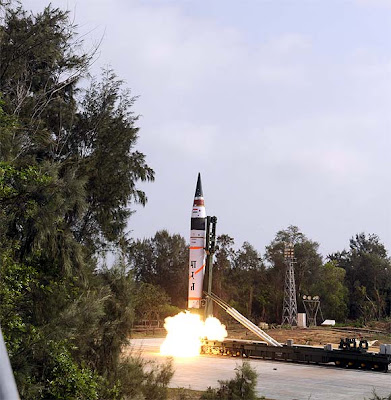Agni-5's launch is a major milestone, India ,joined the elite club of nations
Defence minister A K Antony on Thursday described the maiden test flight of Inter-Continental Ballistic Missile (ICBM) Agni-5 as an "immaculate success" and a "major milestone". "The nation stands tall today. We have joined the elite club of nations (to possess the ICBM capability)," Antony told the DRDO chief Dr V K Saraswat on phone after the test flight of the missile was declared successful on Thursday. "The immaculate success of the Agni-5 is a major milestone in the country's missile research and development programme," he said. The about 5,000 km range Agni-5 was launched from a test range at Wheeler Island off the coast of Odisha at 0807 hours and took 15 minutes to reach its target in southern Indian Ocean. The missile achieved all the mission parameters and has turned out to be a huge success, defence ministry officials said. The launch was cancelled last night due to bad weather and a spate of heavy lightning in the test range. Antony also spoke to the Agni-5 project director Dr Avinash Chander and congratulated his entire team for their hard work and dedication. DRDO took four years to develop the missile. In his conversation with Dr Saraswat and Dr Chander, Antony told them that the nation is proud of its defence scientists and recalled the contributions made by former DRDO chiefs, specially Dr M Natarajan, a brain behind success of various projects such as MBT Arjun and pioneering efforts in LCA Tejas and Pinaka MBRL projects.
AGNI- 5 LAUNCH - CHINA REACTS CAUTIOUSLY, SAYS INDIA NOT ITs RIVAL
Reacting cautiously to India's test of the Agni 5 missile, China on Thursday said the two countries are not rivals and enjoy "sound" relations.
"China has taken note of reports on India's missile launch. The two countries have a sound relationship. During the (recently held) BRICS meeting (in Delhi) the leadership had consensus to take the relationship further and to push forward bilateral strategic cooperative partnership," Chinese foreign ministry spokesman Liu Weimin told a media briefing in Beijing when asked about the launch.
In Delhi, diplomatic sources in the Chinese embassy said, "The Agni 5 launch can give rise to another round of arms race in this part of the world."
Asked whether China was concerned as most of the country would come under the Agni's range, Liu said, "Both countries are emerging powers. We are not rivals. We are cooperative partners. We should cherish the hard earned momentum of cooperation."
But China's state-run Global Times came out with a strong editorial criticising the launch, claiming that the Chinese nuclear power is more "stronger and reliable" and New Delhi has "no chance" to catch up.
"India should not overestimate its strength. Even if it has missiles that could reach most parts of China, that does not mean it will gain anything from being arrogant during disputes with China. India should be clear that China's nuclear power is stronger and more reliable. For the foreseeable future, India would stand no chance in an overall arms race with China," stated The The Global Times article further said that while India's path for boosting its military strength has not met too many obstacles, the country is still poor and lags behind in infrastructure construction.
It also criticized the West for consistently overlooking India's disregard of nuclear and missile control treaties.
It questioned why the West remains silent about the fact that India's military spending increased by 17 percent in 2012 and the country has again become the largest weapons importer in the world.
The paper warned India against overstating the value of its Western allies and the profits it could gain from participating in the containment of China. If it equates long-range strategic missiles with the deterrence of China, and stirs up further hostility, it could be sorely mistaken, stated The Global Times.Global Times.



















